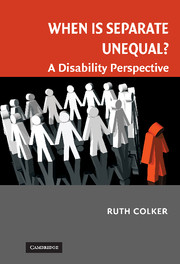Book contents
- Frontmatter
- Contents
- Preface
- Acknowledgments
- 1 Introduction
- 2 Anti-Subordination Above All: A Disability Perspective
- 3 The Mythic 43 Million Americans with Disabilities at the Workplace
- 4 K–12 Education
- 5 Higher Education and Testing Accommodations
- 6 Voting
- 7 Reflections on Race: The Limits of Formal Equality
- Index
5 - Higher Education and Testing Accommodations
Published online by Cambridge University Press: 05 June 2012
- Frontmatter
- Contents
- Preface
- Acknowledgments
- 1 Introduction
- 2 Anti-Subordination Above All: A Disability Perspective
- 3 The Mythic 43 Million Americans with Disabilities at the Workplace
- 4 K–12 Education
- 5 Higher Education and Testing Accommodations
- 6 Voting
- 7 Reflections on Race: The Limits of Formal Equality
- Index
Summary
In chapter 4, i argued that the courts should be more agnostic in determining whether the appropriate educational placement for a child is in the most integrated setting possible. I offered this argument from an anti-subordination perspective under which one would not presume that segregated tools are more effective than integrated tools in attaining substantive equality. Instead, I insisted that we consider what educational tools are most likely to be effective for each individual child and suggested that a “continuum of services” model under which remedies are chosen from a wide range of options would best serve the individual child.
Regrettably, some people might interpret my recommendations from Chapter 4 to suggest that I am opposed to integrated solutions. In fact, nothing could be further from the truth. When the available evidence suggests that integration is the most appropriate tool, I am an avid fan of integration.
The higher education context can demonstrate how we, in fact, could do a better job of using more integrated tools while also serving the needs of a wide cross-section of students with disabilities. To make this argument, I will focus on one aspect of higher education – testing – with particular emphasis on testing within the law school context. Because I believe that the empirical evidence must be assessed rigorously in deciding what solutions are most appropriate, I have limited myself to that context. Much of my argument, however, would apply to other contexts.
- Type
- Chapter
- Information
- When is Separate Unequal?A Disability Perspective, pp. 141 - 216Publisher: Cambridge University PressPrint publication year: 2008



